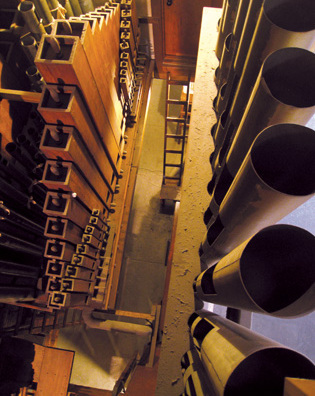 loading
loading
featuresThe behemoth of Woolsey HallThe Newberry Memorial, one of the country's greatest pipe organs, is lovingly maintained with curatorial expertise, historical integrity, and the occasional pizza box. Anthony Weiss ’02 is a former staff writer for the Forward newspaper.  Mark Zurolo ’01MFAThe heights of the Great Organ include wooden bourdon pipes controlled by pedals and the round, gold-colored pipes of the organ's facade. View full imageWhen I arrive, Woolsey Hall is almost empty, and I take a moment to look up at what has brought me here -- the Newberry Memorial Organ. I can't even count how many times I've seen its gilded and pilastered array of pipes during concerts, recitals, assemblies, and commencement speeches. Mostly, I'd taken it as part of the scenery and ignored it. Today, however, I'm getting a much closer look. I am going inside the Newberry. My tour guides, Joseph Dzeda and Nicholas Thompson-Allen, are an erudite pair of bewhiskered philosopher-electricians who care for the Newberry and know every pipe, every screw, and every scrap of its history. Joe is a sturdy, medium-sized man with an old-fashioned gray push-broom moustache. Outgoing and prone to colorful disquisitions, he is the front man for the two of them, and for the organ. Nick is a bit taller and more matter-of-fact, with an even more old-fashioned bicycle-handle moustache that blends into a gray beard. They meet me at the front of the hall and conduct me over to a ladder, stage right, that will lead us up to the balcony and into the organ's innards. Joe pauses to draw my attention to the ladder. "You see that if you put it on level ground, it's uneven -- it's been twisted out of shape," he says. He leans it against the balcony. "But you put it where it belongs and it works perfectly. Like so many of us, it's been trained to do its job very well." With that, we ascend.
The Newberry is considered one of the world's great organs, a uniquely American masterpiece that combined the most advanced technology of its day with immaculate craftsmanship. Playing the Newberry has been a pilgrimage for some of the greatest organists of the modern era, including Marcel Dupre, E. Power Biggs, and Virgil Fox. It remains in high esteem: the acclaimed French organist Daniel Roth has called it "the greatest orchestral organ in the United States." "It's a superb example of the organ builder's art," says New York Times writer Craig R. Whitney, author of All the Stops, a book that traces the development of organ-building in America. "It's in a hall whose acoustics are perfect for an organ, and it's beautifully maintained, so it's survived as a pristine example of an organ ideal from almost 100 years ago. It sounds as good today as it ever did." "It's just a fantastic-sounding instrument," says concert organist Kenneth Cowan ’99MusM. "It's one of the softest organs I've ever heard and also one of the loudest. A lot of romantic music calls for imitative sounds" -- pipes that sound like flutes, or oboes, or trombones -- "and those are all really beautiful. The overall sound is warm, but also clear." And yet the fact that the Newberry remains intact is a minor miracle. Most of its contemporaries have long since been altered, gutted, or ripped out entirely. Its survival in such pristine form is a testament to the efforts of Joe and Nick and Nick's father, Aubrey Thompson-Allen, who cared for the organ before them and trained them to follow in his footsteps.
|
|